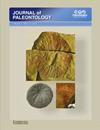Taxonomy and paleobiogeography of rudist bivalves from Upper Cretaceous strata, Gulf Coastal Plain and Puerto Rico, USA
IF 1.6
4区 地球科学
Q3 PALEONTOLOGY
引用次数: 0
Abstract
Abstract. This study provides the first focused investigation of rudist bivalves from the Upper Cretaceous of the Gulf Coastal Plain (GCP) in the southern US and previously undescribed specimens from the Flor de Alba Limestone Member of the Pozas Formation in Puerto Rico. Identified rudists from the GCP comprise the Monopleuridae, including Gyropleura, as well as Radiolitidae, including Biradiolites cardenasensi, Durania maxima, Guanacastea jamaicensis, Radiolites acutocostata, and Sauvagesia. Integrating rudist occurrences within well-established GCP biostratigraphy allows for extension of upper ranges of D. maxima and R. acutocostata into the late Campanian, and extension of the lower ranges of B. cardenasensis and G. jamaicensis into the early Campanian. Identified rudists from Puerto Rico comprise the Hippuritidae and include Barrettia monilifera, which supports the age of the Flor de Alba Limestone Member of the Pozas Formation as middle Campanian. Combined taxonomic, biostratigraphic, and paleobiogeographic analyses indicate there is no rudist fauna endemic to the GCP, and the region marks the northeastern range of the Caribbean genera Biradiolites, Durania, Guanacastea, Gyropleura, Radiolites, and Sauvagesia during the Campanian and Maastrichtian. The new occurrences help inform future updates of Late Cretaceous sea surface-current reconstructions for the Caribbean and Western Interior Seaway, USA.美国墨西哥湾沿岸平原和波多黎各上白垩纪地层中厚壳双壳类的分类和古生物地理学
摘要本研究首次对美国南部墨西哥湾沿岸平原(GCP)上白垩纪的rudist双壳类进行了重点研究,并对波多黎各Pozas组的Flor de Alba石灰岩成员进行了先前未描述的标本。从GCP中鉴定出的芦苇包括单胸膜虫科,包括Gyropleura,以及放射石虫科,包括Biradiolites cardenasensi, Durania maxima, Guanacastea jamaicensis, Radiolites acutocostata和Sauvagesia。在已建立的GCP生物地层中整合rudist产状,可以将D. maxima和R. acutocostata的上部范围扩展到晚坎帕纪,将B. cardenasensis和G. jamaicensis的下部范围扩展到早坎帕纪。在波多黎各发现的rudists包括Hippuritidae,包括Barrettia monilifera,它支持Pozas组的Flor de Alba石灰岩成员的中坎帕尼亚时代。综合分类、生物地层学和古生物地理分析表明,GCP没有特有的原始动物群,该地区标志着坎帕纪和马斯垂纪期间加勒比Biradiolites属、Durania属、Guanacastea属、Gyropleura属、Radiolites属和Sauvagesia属的东北范围。这些新发现有助于为美国加勒比海和西部内陆海道晚白垩世海流重建的未来更新提供信息。
本文章由计算机程序翻译,如有差异,请以英文原文为准。
求助全文
约1分钟内获得全文
求助全文
来源期刊

Journal of Paleontology
地学-古生物学
CiteScore
2.80
自引率
7.10%
发文量
94
审稿时长
6-12 weeks
期刊介绍:
The Journal of Paleontology publishes original articles and notes on the systematics, phylogeny, paleoecology, paleogeography, and evolution of fossil organisms. It emphasizes specimen-based research and features high quality illustrations. All taxonomic groups are treated, including invertebrates, microfossils, plants, vertebrates, and ichnofossils.
 求助内容:
求助内容: 应助结果提醒方式:
应助结果提醒方式:


